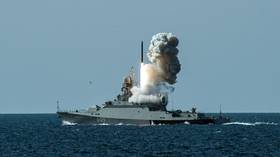‘May the (Space) Force be with you,’ Congress tells Trump in new Pentagon budget bill
US Space Force is about to become a sixth branch of the military, courtesy of Congress going along with President Donald Trump’s popular campaign promise even as Democrats try to impeach him from office.
Included in the 3,500-page National Defense Authorization Act (NDAA) for the fiscal year 2020 is the provision recognizing space as a warfighting domain and establishing the Space Force as a separate service branch. While it is a step up from the current Space Command, the USSF will still be embedded under the US Air Force, in an arrangement mirroring the relationship of the Marines and the Navy.
“Congress – don’t delay this anymore! I will sign this historic defense legislation immediately!” Trump tweeted on Wednesday.
Wow! All of our priorities have made it into the final NDAA: Pay Raise for our Troops, Rebuilding our Military, Paid Parental Leave, Border Security, and Space Force! Congress – don’t delay this anymore! I will sign this historic defense legislation immediately!
— Donald J. Trump (@realDonaldTrump) December 11, 2019
Space Force’s budget will start at $72.4 million, which is a tiny sliver of the $738 billion allocated to the Department of Defense by the 2020 NDAA. Prospective space cadets will have to wait a bit longer, however, as the new branch will not start adding personnel until it finishes transitioning from Space Command.
An overview of the USSF, published by the Air Force earlier this year, envisions the new branch starting with just 200 or so people, and growing to around 15,000 by the end of fiscal 2024.
The conference agreement harmonizing the House and Senate versions of the NDAA creates the office of Chief of Space Operations (CSO), who will report directly to the Air Force Secretary and get a seat on the Joint Chiefs of Staff. The bill provides for the current head of the US Space Command, Air Force General John ‘Jay’ Raymond, to serve as CSO for the first year, and help with the transition to a full service branch.
Also on rt.com ‘Ultimate high ground’: Pentagon launches US Space Command, crosses fingers for Space ForceTrump first floated the idea of a 'Space Force' in a March 2018 speech. The concept proved so popular among his supporters that he soon included it in a list of campaign promises. For a while it seemed like Congress might put the brakes on his ambitions, as the funding for a separate service branch just wasn’t there. Trump settled for ordering the creation of the Space Command in February 2019, and made it happen in August.
Many questions about the Space Force still remain. The US does not currently have a civilian crewed spaceship, but the Air Force has used what looks like a smaller version of the defunct Space Shuttle to conduct classified missions in orbit.
It is also unclear how the USSF will mesh with the 1967 Outer Space Treaty, which prohibits the deployment of weapons in Earth’s orbit, and to which the US is a signatory party. It would not be the first time the Trump administration unilaterally withdraws from an international treaty it deems no longer useful to Washington’s interests, however.
Think your friends would be interested? Share this story!













